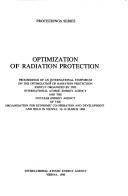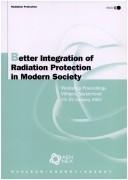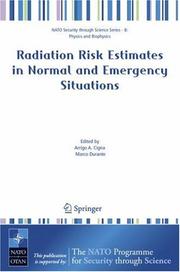| Listing 1 - 6 of 6 |
Sort by
|
Book
ISBN: 9789264042094 9264042091 9786611719661 1281719668 9264042229 9789264042223 Year: 2007 Publisher: Paris : Nuclear Energy Agency, Organisation for Economic Co-operation and Development,
Abstract | Keywords | Export | Availability | Bookmark
 Loading...
Loading...Choose an application
- Reference Manager
- EndNote
- RefWorks (Direct export to RefWorks)
The OECD Nuclear Energy Agency (NEA) has actively participated in discussions with the International Commission on Radiological Protection (ICRP) regarding the development of new recommendations that will replace those in ICRP Publication 60, which has long served as the international standard in this field. Part of this development process has involved the organisation of seven international workshops, including the First and Second Asian Regional Conferences on the Evolution of the System of Radiological Protection which took place in Tokyo, Japan in October 2002 and July 2004. The Third Asian Regional Conference was held on 5-6 July 2006, also in Tokyo. These proceedings summarise the results and key discussions of the Third Asian Regional Conference.
Radiation --- Rayonnement --- Safety measures --- Congresses. --- Sécurité --- Mesures --- Congrès --- Radiation -- Safety measures -- Congresses. --- Radiation. --- Radioactive wastes -- Management -- Congresses. --- Residuos radiactivos -- Administración -- Congresos. --- Radioactive wastes --- Mechanical Engineering --- Engineering & Applied Sciences --- Nuclear Engineering --- Management --- Japan --- Radioactive waste disposal

ISBN: 9200203868 9789200203862 Year: 1986 Volume: vol *102 Publisher: Vienna: International atomic energy agency,
Abstract | Keywords | Export | Availability | Bookmark
 Loading...
Loading...Choose an application
- Reference Manager
- EndNote
- RefWorks (Direct export to RefWorks)
Radiation --- Safety measures --- Congresses --- 621.039.58 <063> --- -Physics --- Radiology --- Safety considerations. Siting, containment, fault analysis etc.--Congressen --- -Congresses --- -Safety considerations. Siting, containment, fault analysis etc.--Congressen --- 621.039.58 <063> Safety considerations. Siting, containment, fault analysis etc.--Congressen --- -621.039.58 <063> Safety considerations. Siting, containment, fault analysis etc.--Congressen --- Physics --- Safety measures&delete& --- Report --- Radiation - Safety measures - Congresses

ISBN: 1280034513 9786610034512 9264196137 9789264196131 9264196943 Year: 2002 Publisher: Paris Organization for Economic Cooperation and Development. Nuclear Energy Agency
Abstract | Keywords | Export | Availability | Bookmark
 Loading...
Loading...Choose an application
- Reference Manager
- EndNote
- RefWorks (Direct export to RefWorks)
The societal aspects of risk governance are increasingly becoming a part of public decision-making processes. This tendency is particularly evident in matters dealing with the protection of human health and the environment. The NEA Committee on Radiation Protection and Public Health organised a workshop to examine stakeholder involvement processes through which governments and regulators can arrive at accepted decisions regarding radiological protection. An example of an area in which stakeholder involvement is important is the clean-up of sites contaminated by accidents or by past industrial or research activities. These proceedings address the roles of various stakeholders in the decision-making process, and their expectations regarding how a modern system of radiological protection should be integrated within the broader context of risk governance. Case studies are presented to illustrate good practice and as a basis for drawing conclusions regarding general lessons that can be applicable in many different national contexts. These proceedings will be of interest to policy makers, radiation protection experts and interested members of the public.
Nuclear industry -- Decision making -- Congresses. --- Nuclear industry. --- Radiation -- Safety measures -- Congresses. --- Radiation --- Nuclear industry --- Public Health --- Environmental Health --- Health & Biological Sciences --- Safety measures --- Decision making --- Atomic energy industries --- Atomic industry --- Atomic power industry --- Nuclear energy industry --- Nuclear power industry --- Energy industries --- Nuclear energy --- Switzerland --- Rayonnement --- Industrie nucléaire --- Congresses --- Sécurité --- Mesures --- Congrès --- Prise de décision
Book
ISBN: 1280033835 9786610033836 9264089594 9264085807 Year: 2000 Publisher: Paris : Organisation for Economic Co-operation and Development,
Abstract | Keywords | Export | Availability | Bookmark
 Loading...
Loading...Choose an application
- Reference Manager
- EndNote
- RefWorks (Direct export to RefWorks)
The Nuclear Energy Agency (NEA) initiated its programme of International Nuclear Emergency Exercises (INEX) by a table-top exercise (INEX 1) which allowed the 16 participating countries to examine how their response mechanisms addressed the international aspects of a large-scale nuclear emergency. Based on the experience thus gained, a series of more realistic exercises, INEX 2, has been organised by the NEA. These exercises used as a basis a national-level emergency exercise at an existing power plant, and aimed to achieve three international objectives: the real-time exchange of information,
Nuclear power plants -- Safety measures -- Congresses. --- Radiation -- Safety measures -- Congresses. --- Radiation protection. --- Radioactive substances -- Safety measures -- Periodicals. --- Radioactive substances -- Safety measures. --- Radioactivity -- Safety measures. --- Nuclear power plants --- Emergency management --- Nuclear Engineering --- Mechanical Engineering --- Engineering & Applied Sciences --- Nuclear Risk --- Accidents --- Safety measures --- International cooperation --- International cooperation.
Book
ISBN: 4431998632 4431886583 9786612005213 1282005219 4431886591 Year: 2009 Publisher: Tokyo ; New York : Springer,
Abstract | Keywords | Export | Availability | Bookmark
 Loading...
Loading...Choose an application
- Reference Manager
- EndNote
- RefWorks (Direct export to RefWorks)
Radiation safety and risk management, a critical issue in the nuclear age, is an ongoing concern in the field of radiation health risk sciences. It is the particular mission and task of the Nagasaki University Global COE program to explore human health risks from radiation on a global scale and to come up with measures for overcoming its negative legacies. Ionizing radiation is a well-documented human cancer risk factor, and long-term health consequences in individuals exposed at a young age to such events as the Hiroshima and Nagasaki atomic bombing are now being followed up. Unique and comprehensive, this book introduces updated radiation health-related issues, including the proper collection and analysis of biological samples, cancer research, psychological effects, fair disclosure, and the effects of low-dose exposure as they apply to future public health policy. Also addressed is the need for emergency radiation medicine in case of accidents.
Radiation -- Physiological effect -- Congresses. --- Radiation -- Safety measures -- Congresses. --- Radiation injuries -- Congresses. --- Radiation --- Radiation injuries --- Radioactive Hazard Release --- Radiation, Ionizing --- Neoplasms, Radiation-Induced --- Nuclear Warfare --- Radiation Effects --- Radiation Injuries --- Neoplasms --- War --- Accidents --- Wounds and Injuries --- Electromagnetic Phenomena --- Social Problems --- Diseases --- Radiologic Health --- Public Health --- Physical Phenomena --- Environment and Public Health --- Sociology --- Social Sciences --- Health Care --- Phenomena and Processes --- Anthropology, Education, Sociology and Social Phenomena --- Environmental Health --- Radiology, MRI, Ultrasonography & Medical Physics --- Medicine --- Health & Biological Sciences --- Health aspects --- Safety measures --- Radiotherapy --- Safety measures. --- Radiation monitoring --- Radiation protection --- Medicine. --- Radiology. --- Medicine & Public Health. --- Imaging / Radiology. --- Radiology, Medical. --- Clinical radiology --- Radiology, Medical --- Radiology (Medicine) --- Medical physics --- Radiological physics --- Physics

ISBN: 9781402049545 1402049544 1402049552 9786610726783 1280726784 1402049560 Year: 2006 Publisher: Dordrecht, Netherlands : Springer in cooperation with NATO Public Diplomacy Division,
Abstract | Keywords | Export | Availability | Bookmark
 Loading...
Loading...Choose an application
- Reference Manager
- EndNote
- RefWorks (Direct export to RefWorks)
In September 2005, Yerevan (Armenia) hosted an International Conference dedicated to the 70th anniversary of the publication of the so called "green paper", published by N.W. Timofeeff-Ressovsky, K. Zimmer and M. Delbruck in 1935, entitled "On the origin of gene mutations and gene structure". The importance of this paper for genetics and radiobiology was enormous – not only for radiobiology, but for genetics in general. The "target" of the radiation action was indeed the "gene", that for the first time found a clear, operational definition. The organisers of this Conference proposed to convene scientists from all over the world to discuss the impact of radiation risk estimates in normal and emergency situations. This was the starting point of the NATO Advanced Research Workshop, whose proceedings are published in this book. The parallel development of the Conference and the Workshop resulted in a true synergism, both events taking advantage of the mixed environment of molecular biologists, genetists, radiobiologists, radioecologists, biophysicists, etc. gathered in Yerevan. We were delighted to include a few excellent papers dealing directly with Timofeeff-Ressovsky’s life, and the "green pamphlet". The life and scientific achievements of Timofeeff-Ressovsky are often not well known in western countries, hence we deemed it advisable to include those papers in this book.
Radiation --- Radiation carcinogenesis --- Rayonnement --- Safety measures --- Congresses. --- Dosage --- Sécurité --- Mesures --- Congrès --- Radiation -- Dosage -- Congresses. --- Radiation -- Safety measures -- Congresses. --- Radiation carcinogenesis -- Congresses. --- Risk Assessment --- Congresses --- Radiation Dosage --- Radiation Effects --- Safety --- Radiologic Health --- Epidemiologic Measurements --- Risk --- Radiometry --- Accident Prevention --- Publication Formats --- Risk Management --- Accidents --- Probability --- Public Health --- Investigative Techniques --- Electromagnetic Phenomena --- Organization and Administration --- Publication Characteristics --- Environment and Public Health --- Health Services Administration --- Statistics as Topic --- Analytical, Diagnostic and Therapeutic Techniques and Equipment --- Physical Phenomena --- Phenomena and Processes --- Epidemiologic Methods --- Health Care --- Health Care Evaluation Mechanisms --- Quality of Health Care --- Health Care Quality, Access, and Evaluation --- Nuclear Engineering --- Environmental Sciences --- Earth & Environmental Sciences --- Mechanical Engineering --- Engineering & Applied Sciences --- Risk estimates --- Environment. --- History. --- Human genetics. --- Ecology. --- Biophysics. --- Biological physics. --- Radiation protection. --- Effects of Radiation/Radiation Protection. --- Human Genetics. --- Biophysics and Biological Physics. --- History of Science. --- Safety measures. --- Radiation monitoring --- Radiation protection --- Biological physics --- Biology --- Medical sciences --- Physics --- Balance of nature --- Bionomics --- Ecological processes --- Ecological science --- Ecological sciences --- Environment --- Environmental biology --- Oecology --- Environmental sciences --- Population biology --- Genetics --- Heredity, Human --- Human biology --- Physical anthropology --- Annals --- Auxiliary sciences of history --- Ecology --- Environmental protection. --- Biological and Medical Physics, Biophysics. --- Environmental quality management --- Protection of environment --- Applied ecology --- Environmental engineering --- Environmental policy --- Environmental quality --- Radiation—Safety measures. --- Ecology .
| Listing 1 - 6 of 6 |
Sort by
|

 Search
Search Feedback
Feedback About UniCat
About UniCat  Help
Help News
News